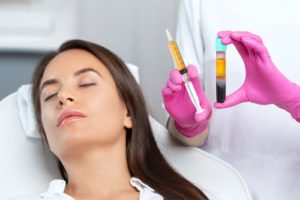In the world of facial lasers, there are numerous devices and technologies to pick from. And while the choices can sometimes be overwhelming, one thing remains certain: a laser facial’s benefits are paramount. From facial veins laser treatments to facials for acne scars and even the best treatments for facial scars so that they’re less noticeable, there’s nothing a laser resurfacing facial can’t do.
These non-surgical, skin-refreshing treatments are beloved for treating various skin concerns, such as unwanted facial veins, redness, sun damage, acne and acne scars, and even rough texture. And thanks to the rise in popularity of laser facials, these treatments show no signs of slowing down, especially since lasers are effective, quick, and provide long-lasting results. In addition, no matter what skin concern the laser facial is treating, they all work the same: delivering a specific wavelength of energy into the skin to target chromophores (specific molecules) within the skin to convert into heat and create the desired end effect.
Still, laser facials (and lasers) are not a one-size-fits-all treatment, and there’s plenty to know before committing to one.
Is a Laser Resurfacing Facial Good For Your Skin?
Laser facial resurfacing is one of the best skin rejuvenating treatments available today. You can address more serious skin concerns like pigmentation, red and brown spots with laser facial resurfacing. A series of treatments can also smooth out fine lines, wrinkles, and scars and increase collagen and elastin production, which decreases with age. Most laser resurfacing facials work by safely ablating or removing the outermost layer of skin, which is later replaced with new, fresh skin as the area heals. Less ablative lasers work similarly, keeping the skin intact with no damage.
How Long Does a Laser Facial Last?
Laser facial resurfacing is a relatively quick treatment that takes about 30 to 60 minutes to perform from start to finish depending on what it’s being used to treat. As far as how long the results of a laser facial last, that depends on several factors, including the type of laser used, the skin’s health before and after treatment, lifestyle and sun exposure habits, and following a good skincare routine. If you take care of your skin, a laser facial’s effects should last several months to a few years. Remember that the less ablative the laser facial, the less intense the results and the shorter they will last. Regardless of the laser used, all laser facial results require maintenance to keep the skin looking its best.
Are Laser Resurfacing Facials Beneficial for Improving Acne Scars?
Yes! Laser facial resurfacing is often recommended for eliminating bothersome signs of acne scars. More ablative lasers physically remove the outermost layer of skin while stimulating new collagen to even out divots, indents, and dips in the skin. There are varying degrees of ablative lasers available. This new collagen helps to smooth the skin’s surface and give it a more evenly textured and toned appearance.
Is A Laser Facial Resurfacing Treatment Painful?
Each facial laser resurfacing treatment is different. However, most lasers, especially more ablative ones, can be uncomfortable, so topical numbing cream makes the treatment more comfortable. Less invasive treatments that use light energy are more tolerable than more ablative ones. The lower the setting, the less you’ll feel on the skin.
Laser resurfacing facial treatments can feel like anything from a rubber band snapping on the skin to a warm sensation that lingers. The treatment intensity depends on the laser setting, which should also consider skin tone to prevent hyperpigmentation. Often, if there’s any discomfort, it is only felt during the treatment and dissipates soon after.
How Should The Skin Be Cared for After a Laser Resurfacing Facial?
The aftercare portion of a laser resurfacing facial is critical to ensure good results and minimize the risk of scars, discoloration, and hyperpigmentation.
Ideally, avoiding the sun at all costs is your best approach. Sun exposure can delay healing and even prevent any redness from entirely dissipating. Sometimes, the sun can undo the effects of the laser, too. It’s also best to take a gentle approach with your skincare products post-laser and not use anything that will irritate or inflame the skin, which will delay healing and cause potential discoloration.
Is There Any Downtime With a Facial Resurfacing Laser?
One of the many reasons patients like facial resurfacing laser treatments is that they are quick, effective, and have next to no downtime. Unlike some older laser resurfacing methods and techniques, these modern-day facial resurfacing lasers rely on controlled and specific heat energy to improve the skin. In addition, there is no recovery or downtime because the outermost layer of the skin is kept intact during the procedure.
Post-treatment, there may be some minimal warmth on the skin or mild soreness, which should subside in a few hours. But there’s no swelling or redness, so you can wear makeup and follow your regular skincare routine.
How Many Facial Laser Resurfacing Treatments Will I Need?
Everyone is different, but most people benefit from a series of laser facial treatments, which will impact the cost of facial laser resurfacing.
Specific skin concerns, like vein removal, for example, often require a series of several treatments over three to six months. Then, to maintain the results, you’ll need one treatment annually after the initial sessions. So, on average, most facial laser resurfacing treatments necessitate at least three, if not more, sessions to reach optimal results.
The more sessions performed, which impacts the facial laser resurfacing cost, the better the results. While some patients notice effects after one treatment, four to six facials may be recommended for optimal results.









